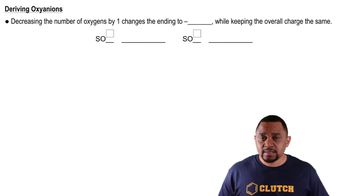Predict the chemical formulas of the compounds formed by the following pairs of ions: (b) Fe3+ and O2-
Predict the chemical formulas of the compounds formed by the following pairs of ions: (e) NH4+ and PO43-.
 Verified step by step guidance
Verified step by step guidance
Verified video answer for a similar problem:
Key Concepts
Ionic Compounds

Polyatomic Ions

Charge Balance

Predict the chemical formulas of the compounds formed by the following pairs of ions: (c) Hg22+ and CO32-
Predict the chemical formulas of the compounds formed by the following pairs of ions: (d) Ca2+ and ClO3-
Complete the table by filling in the formula for the ionic compound formed by each pair of cations and anions, as shown for the first pair. Ion K+ NH4+ Mg2+ Fe3+ Cl- KCl OH- CO32- PO43-
Complete the first row of the table.
Complete the second row of the table.
Complete the third row of the table.
Complete the fourth row of the table.
Complete the table by filling in the formula for the ionic compound formed by each pair of cations and anions, as shown for the first pair. Ion Na+ Ca2+ Fe2+ Al3+ O2- Na2O NO3- SO42- AsO43-
Predict whether each of the following compounds is molecular or ionic: (a) B2H6
